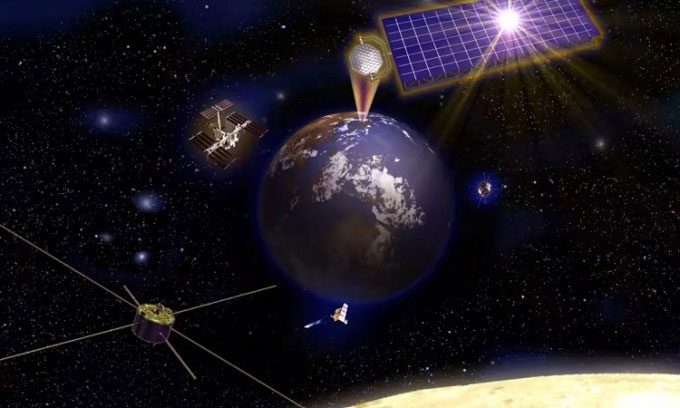Researchers at Kyoto University to Test Solar Power Transmission from Space to Earth via Microwaves in 2025.
The global race to develop solar power transmission technology from space to Earth is heating up. In Japan, a group led by Hiroshi Matsumoto, the former president of Kyoto University, is at the forefront of this research. Professor Naoki Shinohara at Kyoto University is continuing the study, according to a report by Nikkei on May 27.

Simulation of solar power generation system in space. (Photo: Yahoo).
In 2009, Shinohara’s team used a balloon to transmit electricity from a height of 30 meters to mobile phones on the ground. That same year, Shinohara was appointed to lead the technology council of a project from the Ministry of Economy, Trade and Industry to develop wireless power transmission methods. Scientists in the project successfully conducted horizontal microwave transmission experiments in 2015 and vertical experiments in 2018, both from a distance of 40 meters. They plan to test vertical transmission over distances of 1 to 5 kilometers in the future.
Currently, the research team is planning to experiment with transmitting electricity from space to Earth in 2025. They will use small satellites to deliver power to receiving stations on the ground at distances of hundreds of kilometers.
The concept of harvesting solar power in space was proposed by American physicists in 1968. Their approach involved launching photovoltaic cells into space to generate electricity at an altitude of 36,000 kilometers. Solar energy is converted into microwaves, a type of electromagnetic radiation used in microwave ovens, and transmitted to receiving stations on the ground to be converted back into electricity. Microwaves can penetrate clouds, providing a stable electricity supply regardless of the time of day or weather conditions.
The research community is seeking ways to commercialize this technology. Both the U.S. Air Force Research Laboratory and the California Institute of Technology are pursuing large-scale projects. Similarly, Chongqing University in China and the European Space Agency have their own plans to transmit electricity from space to Earth amid the energy crisis, which has led to increased interest in solar power in space.
However, costs remain a major challenge. Producing about one gigawatt of electricity (equivalent to a nuclear reactor) through solar energy requires large photovoltaic panels. Even with advanced technology, installing such panels is likely to cost over $7.1 billion.


















































